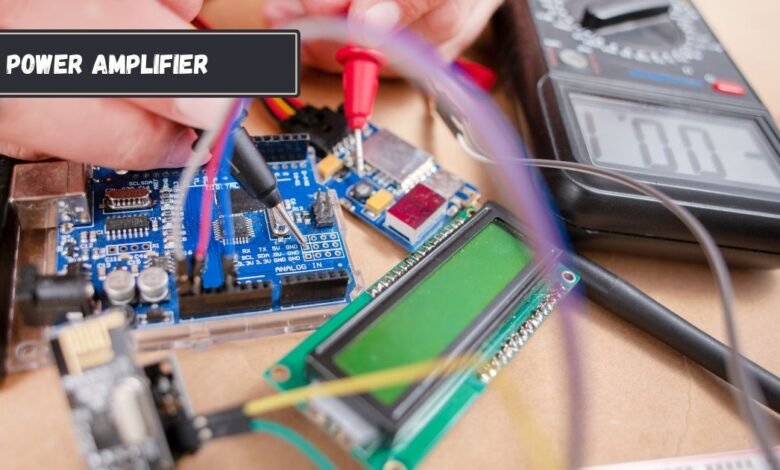A Comprehensive Guide to DIY Power Amplifier 2024

I was worried about starting this task. The time between purchasing the components and actually building the amplifier was not insignificant—it was actually two years. I can read and comprehend electronic schematics and have some experience with analog electronics, but I have never created something from scratch that plugs into a wall outlet.
And I typically use electronics to create either “proof of concept” or kid-oriented products, where precision and minutiae are not as important. Put differently, my insecurities stemmed from my role as a manufacturer of Serious Amplifiers.
In this article i will provide the details and the complexities of building your own power amplifiers at home and offers audio aficionados practical advice and insights.
Understanding Power Amplifiers
What is a Power Amplifier?
An electrical device known as a power amplifier raises the amplitude of a signal to a level that is appropriate for powering speakers or other output devices, usually from a low-level input signal like that from a preamplifier.
Importance of Power Amplifiers
Diy Power amplifiers are essential parts of audio systems because they supply the power needed to improve speakers effectively. The overall sound quality and performance of an audio setup are significantly impacted due to the quality of a power amplifier.
Types of Power Amplifiers
Class A Amplifiers
Although they are less efficient than other classes, class A amplifiers have the highest linearity of operation. Their exceptional sound clarity and little distortion are popular features.
Class AB Amplifiers
Class AB amplifiers combine the efficiency of Class B amplifiers with the level of sensitivity of Class A amplifiers.. Their balanced performance makes them popular in audio applications.
Class D Amplifiers (Digital Amplifiers)
Class D amplifiers use a technique is known as pulse-width modulation, or PWM, to get excellent efficiency, which makes them perfect in high-power and portable applications. Their small size and low heat dissipation are popular advantages.
Advantages of DIY Power Amplifiers
Customization
Building your own power amplifier, you can change the design, components, and circuitry to fulfill your needs and tastes. This degree of personalization can produce a customized audio experience.
Cost-Effectiveness
Do-it-yourself projects often save money as compared to purchasing commercial amplifiers of similar quality. You may obtain great performance for a lot less money if you buy the parts and assemble the amplifier yourself.

Learning Experience
DIY amplifier projects offer excellent chances for learning audio engineering, electronics, and circuit design. It enables enthusiasts to polish their soldering and assembly abilities while expanding their knowledge of amplifier operation.
Building Your DIY Power Amplifier
Planning and Research
Prior to beginning your diy power amplifier project, careful preparation and study are essential. This entails deciding on an amplifier architecture (such Class A, Class AB, or Class D), picking right parts (including resistors, capacitors, and transistors), and finding out how much power your speaker system will need to release results.
Schematic Design
Make or collect a thorough schematic diagram for the amplifier circuit of your choice. This schematic, which shows component location, wire connections, and voltage/power requirements, acts as a template for the assembly procedure.
Component Selection
Make sure you choose premium parts from reliable vendors. Power transistors for the output stages, capacitors for the filtering and decoupling, resistors for the biasing and voltage division, and an appropriate power supply unit (PSU) with the ability to supply the necessary voltage and current are important parts.
PCB Layout and Assembly
Create a printed circuit board (PCB) layout, or have one already created for you, using your selected design. The PCB layout should reduce noise, maximize signal integrity, and make assembly easier. In order to create a dependable and stable amplifier, adhere to recommended soldering and component positioning techniques.
Testing and Calibration
After the amplifier circuit is assembled, carry out exhaustive testing and calibration processes. This entails monitoring voltages at different intervals, testing signals both input and output, confirming biasing levels, and making sure that thermal management is enough to avoid overheating.
Enclosure and Finishing
Complete the project by placing the amplifier circuit in a proper enclosure after the amplifier’s operation has been confirmed. Select an enclosure that offers sufficient ventilation, defense against outside influence, and good looks. It can also be helpful to label and record the amplifier’s features and specifications for future use.
Tips for DIY Success
Start Simple
It’s best for beginners to work on basic amplifier designs before moving on to more intricate setups. It helps you to slowly gain confidence and understand basic ideas.
Quality Over Quantity
Give superior materials and building methods precedence before ostentatious features or high power ratings. An amplifier with superior components and meticulous assembly can outperform one with more difficult design and greater specs.
Safety First
Security concerns should always come first while handling high voltages and electrical components. Follow all necessary safety precautions before working on live circuits; use insulated tools, and ground yourself properly.
Seek Expert Advice
Never scared to ask expert electronics fans, forums, or online communities for advice or direction. The experience of building your own amplifier can be improved by taking in the expertise and viewpoints of others.
Conclusion
Constructing a DIY power amplifier is a hectic project that blends technical know-how, artistic vision, and a love of high-quality audio. With a complete understanding of power amplifier concepts, safety component selection, and methodical assembly techniques, hobbyists can build custom amplifiers that fulfill their specific needs and tastes. Accept the do-it-yourself attitude and set out on a fulfilling adventure of skillful audio discovery.
FAQs
Q: What tools are necessary to build a DIY power amplifier?
A: Common tools includeIN a soldering iron, multimeter, wire strippers, and screwdrivers for finding and testing.
Q: How can I find the power output requirements for my DIY amplifier?
A: Consider factors such as speaker impedance, desired volume levels, and room size to calculate the needed power output in watts.
Q: I want to build a homemade amplifier. Can I utilize salvaged parts for it?
A: Salvaged parts can be economical, but for optimal results, make sure they meet all requirements and are in good operating order.
Q: What safety measures ought I to take when assembling a homemade amplifier?
A: Use isolated devices, keep far from working on live circuits, work in areas with good ventilation at all times, and follow to the manufacturer’s welding and component handling safety instructions.
Q: How do I troubleshoot common issues with my DIY amplifier?
A: Start by checking connections, component values, and levels. Refer to the schematic diagram and seek assistance from experienced persons or online communities if needed.





